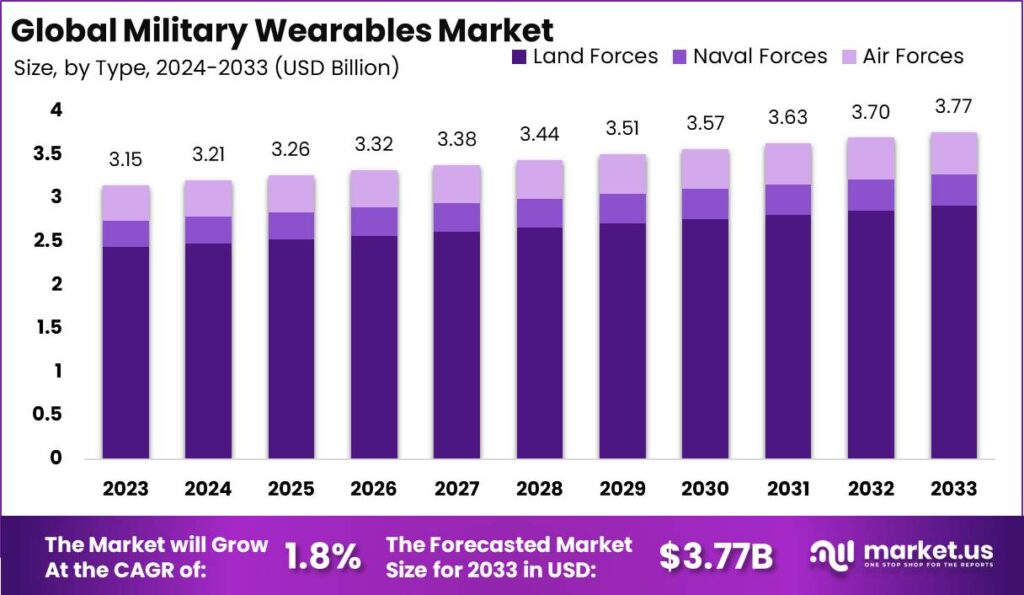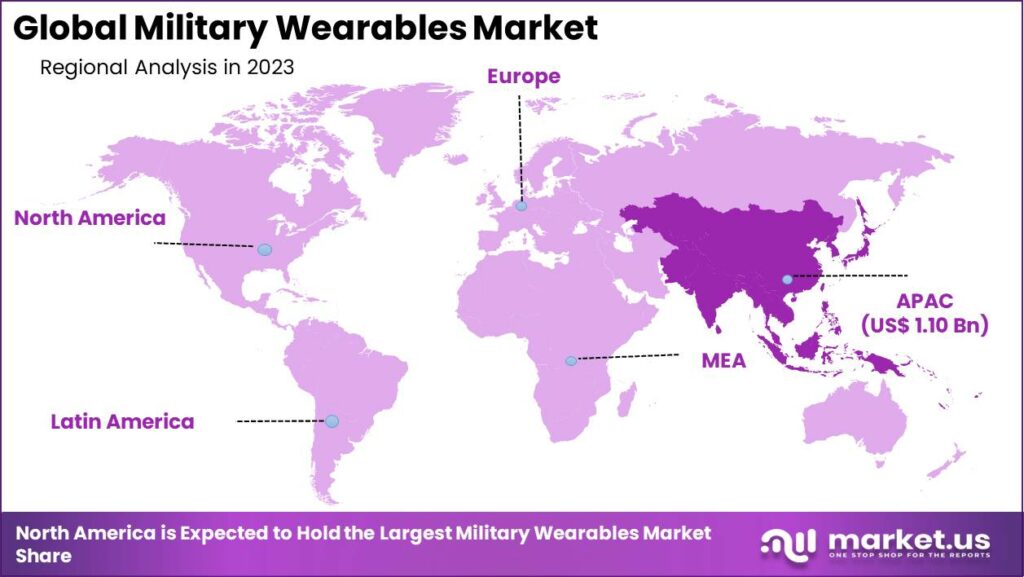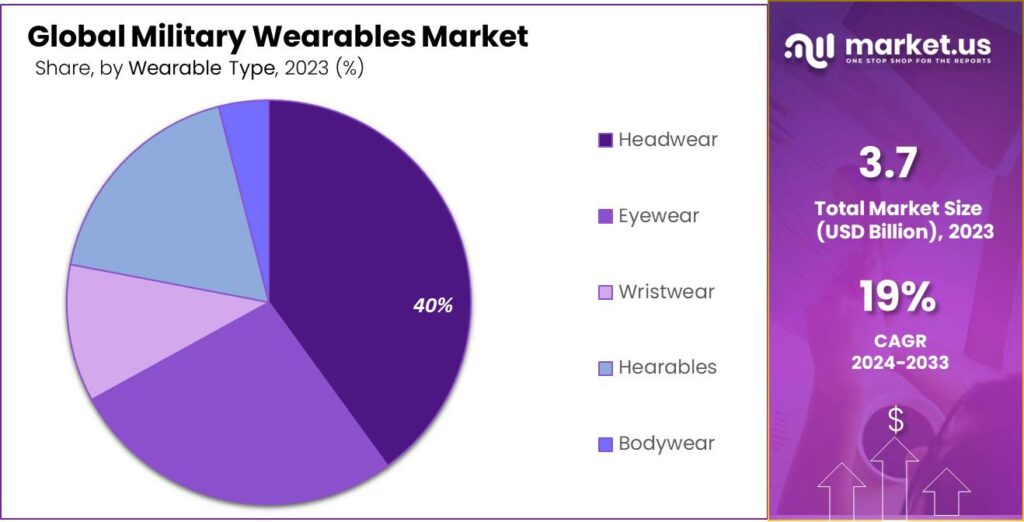New York, Feb. 20, 2024 (GLOBE NEWSWIRE) -- According to Market.us, The global military wearables market is poised for significant growth, with an anticipated value of USD 3.77 billion by 2033, demonstrating a steady Compound Annual Growth Rate (CAGR) of 1.8% from 2024 to 2033.
Military wearables encompass a range of electronic devices integrated into soldiers' uniforms and gear, including augmented reality headsets, smartwatches, fitness trackers, sensors, exoskeletons, and more. These technologies play a crucial role in enhancing soldiers' capabilities by enabling real-time communication, data transfer, vital sign monitoring, navigation, and physical task assistance. Leading military powers such as the United States, China, and Russia are heavily investing in military wearables technology, with a focus on soldier modernization programs and the adoption of augmented reality and virtual reality for training and operations.
The market for military wearables, encompassing a diverse range of technologies and applications, is experiencing notable growth driven by a confluence of factors. Military organizations worldwide are increasingly adopting wearable devices to enhance the effectiveness, safety, and situational awareness of their personnel. These wearables, which include smart helmets, augmented reality (AR) glasses, body-worn sensors, and advanced communication systems, offer a myriad of benefits ranging from real-time battlefield data analysis to improved soldier health monitoring.
Request for Research Methodology to Understand Our Data-sourcing Process in Detail: https://market.us/report/military-wearables-market/request-sample/

Key Takeaways
- The global military wearables market is expected to reach USD 3.77 billion by 2033, with a steady Compound Annual Growth Rate (CAGR) of 1.8% from 2024 to 2033.
- In 2023, the Land forces segment held a dominant market position in the Military Wearables Market, capturing more than a 78% share.
- Vision & Surveillance held the largest market share in 2023 (23%) due to the critical need for enhanced situational awareness in modern warfare.
- Headwear dominated the market in 2023 (40%), including helmets, head-up displays, and communication headsets, crucial for protection and advanced communication.
- APAC held a dominant market position in 2023 (35% share) due to significant military advancements and increasing defense budgets, with a focus on modernizing military capabilities.
Factors Affecting the Growth of the Military Wearables Market
- Technological Advancements: Advancements in sensor technologies, miniaturization, and material science have enabled the development of sophisticated military wearables. These technologies include smart textiles, body-worn sensors, augmented reality (AR) devices, biometric monitoring systems, and communication devices. As these technologies continue to improve, the military wearables market is expected to expand.
- Need for Enhanced Situational Awareness: Situational awareness is crucial in military operations, and wearable devices can provide real-time data and information to enhance soldiers' awareness of their surroundings. Military wearables such as head-up displays (HUDs) and smart glasses can overlay digital information onto the soldier's field of view, providing critical data, navigation assistance, and communication capabilities. The demand for such devices to improve situational awareness is a driving factor for market growth.
- Soldier Health and Performance Monitoring: Military wearables can monitor soldiers' vital signs, activity levels, fatigue, and overall health, allowing commanders and medical personnel to assess their well-being and make informed decisions. These wearables can also provide early warnings for heat stress, dehydration, and other health risks. The focus on soldier health, performance optimization, and injury prevention is driving the adoption of wearable technologies in military settings.
- Communication and Connectivity: Reliable communication and connectivity are essential for military operations. Military wearables equipped with communication capabilities, such as integrated radios or data transmission systems, enable seamless communication between soldiers, commanders, and units. The demand for improved communication and coordination in the field is fueling the growth of wearable communication devices in the military.
Build a Future-proof Business! Buy our Premium Insights at Affordable Prices Now: https://market.us/purchase-report/?report_id=73128
Regional Analysis
In 2023, the Asia-Pacific (APAC) region emerged as a dominant force in the Military Wearables Market, securing a formidable market position by capturing over 35% of the total market share. This remarkable achievement underscores the region's growing significance in the global defense industry and its increasing investment in advanced military technologies.
Several factors contributed to APAC's strong foothold in the military wearables market. Firstly, the region's dynamic geopolitical landscape, characterized by ongoing territorial disputes and security challenges, has spurred governments to bolster their defense capabilities through the adoption of cutting-edge technologies. As a result, APAC countries have been proactive in exploring and deploying innovative wearable solutions to enhance the effectiveness and agility of their armed forces.
Moreover, the rapid economic growth and technological advancement witnessed across many APAC nations have provided a conducive environment for the development and adoption of military wearables. Rising defense budgets, coupled with a burgeoning defense industry ecosystem, have facilitated the research, development, and procurement of state-of-the-art wearable technologies tailored to meet the region's specific defense requirements.

Report Segmentation
By End User Analysis
The dominance of the Land forces segment in the Military Wearables Market in 2023, capturing over 78% of the market share, can be attributed to several factors. Land forces, comprising armies and ground troops, often operate in diverse and challenging environments where situational awareness, communication, and protection are paramount. As a result, there is a high demand for wearable technologies that enhance soldier capabilities, improve communication, and provide real-time data insights on the battlefield. Wearable devices such as smart helmets, body-worn sensors, and communication systems are integral components of modern land force equipment, driving the segment's significant market share.
By Technology Analysis
Similarly, the Vision & Surveillance segment's dominance in 2023, capturing more than 23% of the market share, underscores the critical importance of visual and surveillance technologies in military operations. Vision-enhancing wearables, including night vision goggles, thermal imaging devices, and augmented reality glasses, play a vital role in enhancing situational awareness, target acquisition, and reconnaissance capabilities for ground troops. As military operations increasingly rely on accurate and timely visual information, the demand for vision and surveillance wearables continues to grow, driving the segment's market dominance.
By Wearable Type Analysis
Furthermore, the Headwear segment's leading position in 2023, capturing over 40% of the market share, highlights the significance of head-mounted wearable devices in military applications. Headwear, such as helmets and head-mounted displays, serves as a platform for integrating various technologies, including communication systems, display screens, and sensors, into a single wearable device. These devices not only provide protection to soldiers but also serve as a vital interface for accessing critical information, receiving commands, and interacting with digital overlays in the battlefield environment. The versatility and functionality offered by headwear wearables contribute to their widespread adoption and dominance in the military wearables market.

Click to Request Sample Report and Drive Impactful Decisions: https://market.us/report/military-wearables-market/request-sample/
Top Market Leaders
- BAE Systems PLC
- Elbit Systems Ltd.
- Thales Group
- Saab AB
- General Dynamics Corporation
- Rheinmetall AG
- L3Harris Corporation
- Aselsan A.S.
- Teledyne Flir LLC
- Lockheed Martin Corporation
- Other key players
Recent Developments
1. BAE Systems PLC:
- February 2023: Partnered with Microsoft Azure to develop and integrate wearable augmented reality solutions for military applications, aiming to enhance situational awareness and decision-making.
- June 2023: Unveiled the Tactica X wearable augmented reality headset designed for infantry soldiers, offering real-time data overlay and improved battlefield visibility.
- August 2023: Announced a collaboration with the UK Ministry of Defence to develop next-generation wearable communication systems for soldiers, focused on secure and reliable data transmission.
2. Elbit Systems Ltd.:
- March 2023: Launched the XACT wearable combat system, integrating communication, navigation, and situational awareness tools into a single platform for improved soldier performance.
- October 2023: Signed a contract with the Israeli Ministry of Defense to supply advanced soldier systems, including wearable health monitoring devices and tactical communication solutions.
- December 2023: Partnered with Rafael Advanced Defense Systems to develop integrated wearable solutions for aircrew, combining Elbit's communication expertise with Rafael's missile and countermeasure technologies.
Purchase the Competition Analysis Dashboard Today: https://market.us/purchase-report/?report_id=73128
Impactful Driver:
One of the most impactful drivers shaping the Military Wearables Market is the increasing focus on enhancing soldier effectiveness and survivability on the battlefield. Modern warfare scenarios are characterized by dynamic and complex environments, where soldiers face evolving threats and challenges. As a result, defense organizations worldwide are prioritizing investments in wearable technologies aimed at equipping soldiers with advanced capabilities, enhancing situational awareness, and improving mission effectiveness. The imperative to enhance soldier lethality, agility, and survivability drives the demand for innovative wearable solutions, making it a significant driver in the military wearables market.
Key Trend:
A key trend shaping the Military Wearables Market is the convergence of wearable technologies with artificial intelligence (AI) and machine learning (ML) capabilities. This trend is driven by the growing demand for intelligent and adaptive wearable solutions capable of processing and analyzing vast amounts of data in real-time. By integrating AI and ML algorithms into wearable devices, defense organizations can unlock new capabilities such as predictive analytics, anomaly detection, and autonomous decision-making. This trend not only enhances the functionality and effectiveness of military wearables but also enables proactive and data-driven decision-making on the battlefield, making it a key trend in the market.
Major Challenges:
One of the major challenges facing the Military Wearables Market is ensuring interoperability and compatibility among diverse wearable devices and systems. Military organizations often operate with heterogeneous equipment sourced from different manufacturers and suppliers, leading to interoperability challenges and integration issues. Ensuring seamless communication and data exchange between various wearable devices, sensors, and command systems poses significant technical and logistical challenges. Moreover, maintaining cybersecurity and data integrity across interconnected wearable devices is another major challenge, given the growing threat of cyberattacks and information warfare. Addressing these interoperability and cybersecurity challenges is crucial for ensuring the effective deployment and operation of military wearables in integrated battlefield environments.
Key Market Segments
By End User
- Land Forces
- Naval Forces
- Air Forces
By Technology
- Communication & Computing
- Network and Connectivity Management
- Navigation
- Vision & Surveillance
- Exoskeleton
- Monitoring
- Power and Energy Source
- Smart Textiles
By Wearable Type
- Headwear
- Eyewear
- Wristwear
- Hearables
- Bodywear
By Geography
- North America
- The US
- Canada
- Europe
- Germany
- France
- The UK
- Spain
- Italy
- Russia
- Netherland
- Rest of Europe
- APAC
- China
- Japan
- South Korea
- India
- Australia
- New Zealand
- Singapore
- Thailand
- Vietnam
- Rest of APAC
- Latin America
- Brazil
- Mexico
- Rest of Latin America
- Middle East & Africa
- South Africa
- Saudi Arabia
- UAE
- Rest of MEA
Explore Extensive Ongoing Coverage on Technology Related Reports:
- Identity and Access Management Market was valued at USD 14.7 Bn. Between 2023 and 2032, register the highest CAGR of 13.7%.
- Distributed Antenna System (DAS) Market size is expected to be worth around USD 5.5 Bn by 2033, growing at a CAGR of 7.6%.
- Wearable Technology Market size is expected to be worth around USD 231 Billion by 2032 , growing at a CAGR of 14.60%.
- Digital Currency Market size is expected to be worth around USD 76.9 Bn by 2032 from USD 25.2 Bn in 2022, growing at a CAGR of 12.13%
- Computer Vision Market is projected to reach a valuation of USD 58.9 Bn by 2033, at a CAGR of 13.5%, from USD 16.6 Bn in 2023.
- ERP Software Market size is expected to be worth around USD 136.1 Billion by 2032, growing at a CAGR of 10.5% during the forecast period.
- Field-Programmable Gate Array (FPGA) Market size is expected to reach USD 13.5 bn in 2032, at a CAGR of 7.8%.
- Video Conferencing Systems Market will reach USD 21 Bn in 2032, from USD 11.1 Bn in 2022; CAGR of roughly 8.1% over the next ten years.
- Automation Identification System Market size is expected to be worth USD 491.0 Mn by 2032 from USD 278.2 Mn in 2023, at a CAGR of 6.0%
- Brain Computer Interface Market size is expected to reach USD 7,419.0 Million by 2032, exhibiting an impressive CAGR of 15.7%.
- Digital Signage market is expected to reach USD 52.7 billion in 2032. Between 2023 and 2032, register the highest CAGR of 7.7%.
- Facial recognition market size is projected to surpass at USD 19 Billion by 2032 and it is growing at a CAGR of 14.6% from 2023 and 2032.
About Us
Market.US (Powered by Prudour Pvt Ltd) specializes in in-depth market research and analysis and has been proving its mettle as a consulting and customized market research company, apart from being a much sought-after syndicated market research report-providing firm. Market.US provides customization to suit any specific or unique requirement and tailor-makes reports as per request. We go beyond boundaries to take analytics, analysis, study, and outlook to newer heights and broader horizons.
Follow Us On LinkedIn Facebook Twitter
Our Blog:
